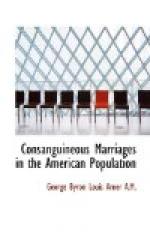This reform, as also the more intelligent attitude of the American people in general towards the affliction of deafness, is due largely to the work of Dr. Alexander Graham Bell. An enumeration of Dr. Bell’s services directly, and through the agency of the Volta Bureau, in this cause, cannot be given here. For our purpose the most important of his contributions is embodied in the Special Report of the Twelfth Census of the United States already referred to.
As in the investigation of the Blind, the circular letter sent to each person reported by the enumerators as deaf contained questions in regard to parentage and the existence of deaf relatives. It is unfortunate that in these returns it is impossible to distinguish between degrees of relationship, but in such an extensive compilation it was doubtless impracticable to attempt to unravel the intricacies of consanguinity. Judging from the returns of the Census of Ireland we may assume that about half of the cases returned as “cousins” were first cousins.
The replies to the inquiry as to deaf relatives were more carefully analyzed, and were divided into four groups, which are referred to throughout as (a), (b), (c) and (d) relatives. These groups are: (a), deaf brothers, sisters or ancestors; (b), deaf uncles, aunts, cousins or other relatives not (a), (c) or (d); (c), deaf children, (sons or daughters); (d), deaf husbands or wives. Thus a large proportion of the hereditary cases would be included in the first two categories, (a) and (b).[88]
[Footnote 88: U.S. Census Report on the Blind and the Deaf, p. 127.]
The causes of deafness are given in detail, but as might be expected the returns are not as definite or as accurate as we should desire. The causes given have been grouped under five main heads; these again are subdivided, often into divisions numerically too minute for real statistical value. Table XXVIII includes the main groups and those specific causes which number more than 3000 cases. The extreme variation in the percentages of those who are the offspring of consanguineous marriages cannot be attributed to mere chance. There is clearly some fundamental connection between consanguinity and congenital deafness if 11.8 per cent of all the congenitally deaf are the offspring of consanguineous marriages, while of the adventitiously deaf but 3.1 per cent are the offspring of such marriages. In fact we are tempted to jump at the conclusion that consanguinity is in itself a cause of deaf-mutism. Furthermore 42.1 per cent of the deaf whose parents were cousins were congenitally deaf, while this was true of but 15 per cent of those whose parents were unrelated.




